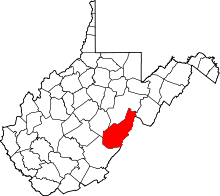Green Bank, West Virginia
| Green Bank | |
|---|---|
| Census-designated place | |
 Green Bank Location within the state of West Virginia | |
| Coordinates: 38°25′12″N 79°49′53″W / 38.42000°N 79.83139°WCoordinates: 38°25′12″N 79°49′53″W / 38.42000°N 79.83139°W | |
| Country | United States |
| State | West Virginia |
| County | Pocahontas |
| Area[1] | |
| • Total | 3.276 sq mi (8.48 km2) |
| • Land | 3.276 sq mi (8.48 km2) |
| • Water | 0 sq mi (0 km2) |
| Population (2010)[2] | |
| • Total | 143 |
| • Density | 44/sq mi (17/km2) |
| Time zone | Eastern (EST) (UTC-5) |
| • Summer (DST) | EDT (UTC-4) |
| ZIP codes | 24944 |
Green Bank is a census-designated place in Pocahontas County in West Virginia's Potomac Highlands inside the Allegheny Mountain Range. Green Bank is located along WV 28. Green Bank is also close to the Snowshoe Mountain ski resort. As of the 2010 census, its population was 143.[2]
The community was named for a green riverbank near the original town site.[3]
National Radio Quiet Zone
Green Bank is located within the National Radio Quiet Zone, which means that radio transmissions are heavily restricted by law. This policy is enforced by a "radio policeman" who uses specialized equipment to detect signals from unauthorized electronics.[4] Green Bank is home to the Green Bank Telescope, the world's largest fully steerable radio telescope, which was operated by the National Radio Astronomy Observatory (NRAO) until September 30, 2016. Since October 1, 2016, the Telescope has been operated by the Green Bank Observatory, which is no longer part of the NRAO. It was at the Green Bank Site in 1961 that Frank Drake presented the Drake Equation, which was developed to provide an estimate of the total number of detectable extraterrestrial civilizations in the Milky Way galaxy.
As Green Bank is located within the Quiet Zone, many people who believe they suffer from electromagnetic hypersensitivity are finding new homes within its borders.[5][6] Escape from cellular radiation is the main attraction to Green Bank for these people.[7] As of 2013, an estimated 36 people have moved to Green Bank to escape the effects of electromagnetic hypersensitivity.[8]
Notable people
- Bruce Bosley, a four-time All-Pro for the San Francisco 49ers and a standout player at West Virginia in the 1950s, starred as running back at the now-closed and demolished Green Bank High School.
References
- ↑ "US Gazetteer files: 2010, 2000, and 1990". United States Census Bureau. 2011-02-12. Retrieved 2011-04-23.
- 1 2 "American FactFinder". United States Census Bureau. Archived from the original on 2013-09-11. Retrieved 2011-05-14.
- ↑ Kenny, Hamill (1945). West Virginia Place Names: Their Origin and Meaning, Including the Nomenclature of the Streams and Mountains. Piedmont, WV: The Place Name Press. p. 282.
- ↑ "Silence! Scientists are listening to the universe". NBCNews.com. Retrieved 2015-11-11.
- ↑ "Electromagnetic hypersensitivity: Evidence for a novel neurological syndrome". D.E. McCarty, S. Carrubba, A.L. Chesson, Jr., C. Frilot II, E. Gonzalez-Toledo & A.A. Marino. Int. J. Neurosci. 121:670–676, 2011. [PDF file]. (Introduction, an MP3 audio file).
- ↑ O'Brien, Jane; Danzico, Matt (September 12, 2011). "'Wi-fi refugees' shelter in West Virginia mountains". BBC News. Retrieved April 13, 2013.
- ↑ Fisher, Kristin (27 February 2013). "Wireless Refugees: 'Cell Phones, WiFi Making Us Sick'". WUSA Channel 9 (transcript of television news feature). Retrieved 13 April 2013.
- ↑ Joseph Stromberg (April 12, 2013). "Refugees of the Modern World". Slate. Retrieved April 12, 2013.
